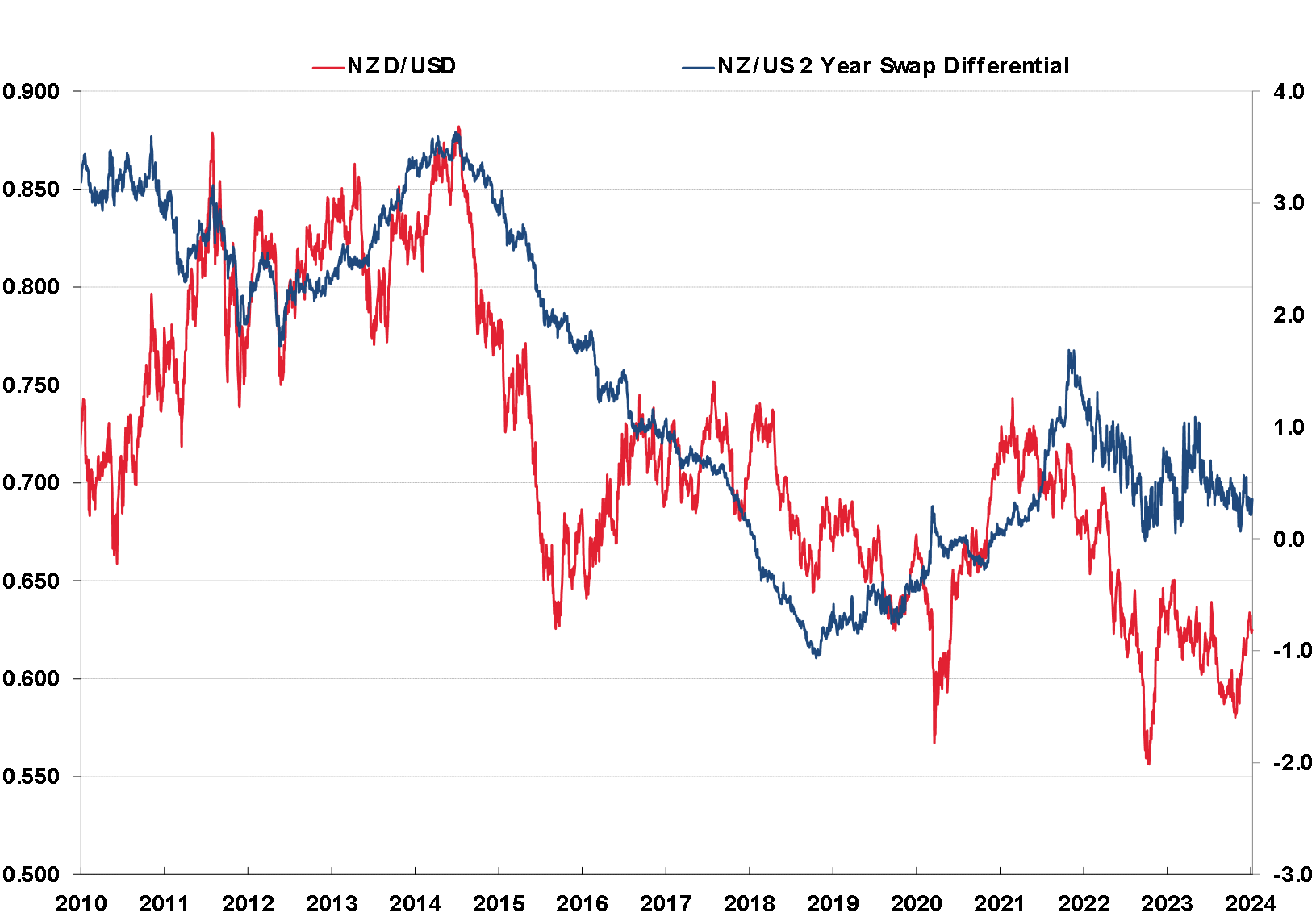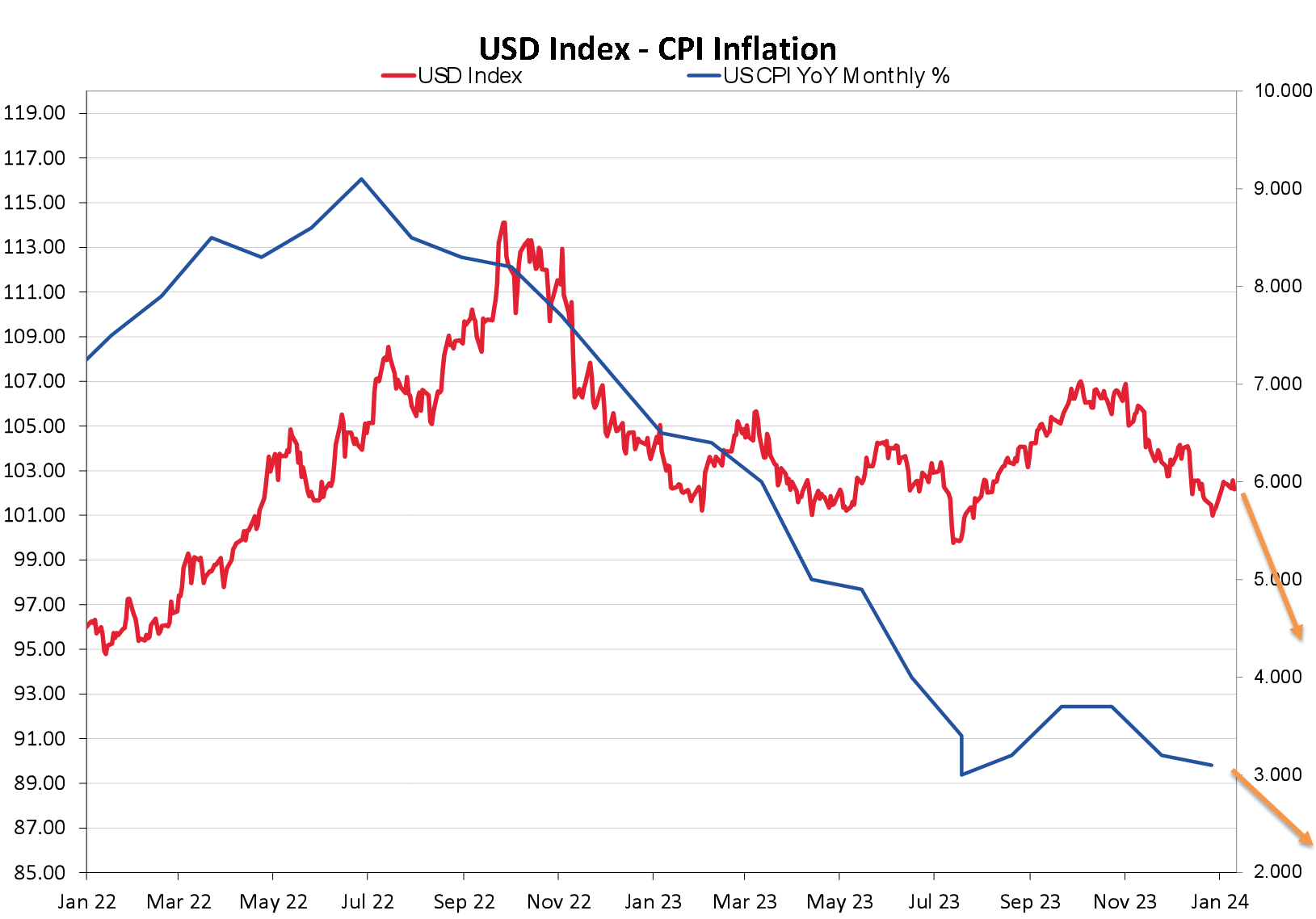
Summary of key points: -
- Higher yielding currencies returning to favour?
- Inflation outlook for New Zealand
- Inflation outlook for the US
Higher yielding currencies returning to favour?
Relative pricing movements and the timing of those movements of interest rates in the US, Australia and New Zealand are standing to play a dominating part in determining exchange rate movements in 2024.
The big question for organisations with exposure to NZD/USD exchange rate changes, is whether the so-called “high yielding” currencies such as the NZD and AUD will come back into favour with global investors/traders and that buying pressure causing independent appreciation?
In addressing the question as to whether NZ interest rates are sufficiently above US interest rate yields to be attractive enough for traders to take on the currency bet, the current interest rate differential needs to be examined against historical levels relative to the NZD/USD exchange rate movements.

The current gap between New Zealand two-year swap interest rate at 4.74% and the US two-year swap at 4.41% is just 0.33%, and by historical gauges that is insufficient to single the Kiwi dollar out as an attractive higher yielding currency to buy on its own account. The gap between the one-year swap interest rates in the US and New Zealand is also around 0.33% currently.
However, the prime driver of exchange rate direction is the future interest rate differential, not the current gap. The two-year swap interest rates today do price-in all current expectations about what the respective central banks will be doing with their official cash rate (RBNZ) and Fed Funds rate (US Fed) over the next two years. Given the current levels of inflation in New Zealand (5.60%) and the US (3.40%), it would seem that the US interest rate market is not yet pricing-in enough reductions in interest rates. In contrast, on the other side, there is a strong argument that the New Zealand interest rate market is pricing in far too many cuts, far too early, from the current 5.50% OCR rate. Just on current differences in inflation rates, it would appear that NZ two-year swap rates should be at least 1.00% above US two-year swap rates.
Historically, when the two-year swap interest rate differential (blue line on chart) reduces, the NZD/USD exchange rate depreciates (2015 to 2019 and 2022 until late 2023). Conversely, when the interest rate differential climbs (2019 to 2021), the Kiwi dollar generally moves higher. A forward view on the interest rate gap increasing to above 1.00% to say 1.50% this year would suggest that the NZD/USD rate is going to end up a lot closer to 0.7000 than 0.6000.
The expected future shifts in the respective two-year interest rates have to be framed in the context of inflation trends in both the NZ and US and the subsequent responses by the RBNZ and the Fed.
Inflation outlook for New Zealand
New Zealand’s annual inflation rate is set to reduce from 5.60% to 4.50% when the December 2023 quarter numbers are released on 24th January. Consensus forecasts are for a low 0.30% increase over the quarter as fuel prices reduce and large price increases in the December 2022 quarter drop out of the annual figures. Such an outcome would be well below the RBNZ forecast of +0.80% for the quarter. A more likely result of around +0.60% would be positive for the Kiwi dollar as it is above consensus forecasts.
You hear of convincing arguments that the “last mile” in getting inflation down from 3.00% to 2.00% is much more difficult than reducing inflation from 7.00% to 3.00%. In New Zealand’s case, analysis shows that our tradable inflation rate will have to move to negative to pull our overall annual inflation rate to anywhere near 2.00% to 3.00%. The reason being that our non-tradable inflation (domestic prices) has consistently increased between 3.00% and 4.00% every year for many years (due to public sector cost-plus pricing and economies of scale reducing competition in the private sector). Nothing has changed in New Zealand to suggest that non-tradable inflation is going to suddenly decline below its historical increases. Surely, the mandarins at the RBNZ can work out the NZ economy will need a higher exchange rate to reduce imported goods prices (to push tradable inflation into the negative) to have any chance of achieving the 1.00% to 3.00% inflation target over the coming 12 to 18 months.
Currency market traders will certainly work out that the RBNZ will need to hold our interest rates “higher for longer” in 2024 to have any chance of pulling New Zealand’s stubborn, wage-push inflation rate down. Therefore, the NZ two-year swap interest rate will be remaining at 4.74% for most of this year.
Inflation outlook for the US
The surprising element in the recent US inflation figures for the month of December was that the “shelter” (rents and implied rents = cost of housing) still increased by 0.50% over the month. The shelter component represented 50% of the 0.30% increase in the overall inflation rate for the month. Annual shelter price increases are still running at 6.20% in the official CPI inflation measure, however that bares absolutely no resemblance to actual current market house rents in the US which are calculated at an 3.30% increase for 2023 by the Zillow market rental report. The incredibly legged shelter CPI price data is disturbingly distorting accurate measures of current inflation in the US and unnecessarily holding interest rates higher than where they need to be.
It is inevitable that the monthly increases in the shelter CPI will decrease over coming months and cause surprises for the financial markets as monthly inflation figures come out below consensus forecasts. It is instructive that US 10-year bond yields have recently moved below 4.00% again to 3.94% despite the December jobs and inflation data being above forecast. US wholesale prices (Producers Price Index) decreased by 0.10% in December, delivering an annual PPI increase of just 1.00%. Add on lower oil prices and imported deflation from China, you have to conclude that the markets have probably got it right with no change to the 70% probability of the first Fed rate cut in March (despite the recent higher than expected jobs and CPI data).
The annual US inflation rate is on track to fall below 3.00% into the 2.00% region over coming months and with that comes a weaker US dollar value on further reductions in US interest rates. The US two-year swap interest rate is unlikely to remain above 4.00% in a 2.00% annual inflation environment. Our view remains unchanged that the USD Dixy Index (currently 102.17) will have another leg down to 95.00 as it follows further falls in US inflation (refer chart below).

Daily exchange rates
Select chart tabs
*Roger J Kerr is Executive Chairman of Barrington Treasury Services NZ Limited. He has written commentaries on the NZ dollar since 1981.
10 Comments
He blames government. He suggests government are lax buyers who accept any price on a 'cost-plus' basis. I.e. suppliers simply present government with the cost - with higher wages baked in. Given some big government contracts can run for years the supplier has to build in some expectation of wages increases. He suggest 'wage-push' inflation comes from this source. Dubious conclusion when we see how much greedflation adds to prices.
Isn’t there a reasonable chance that tradable inflation will push 0% or even go negative? If the Fed was to cut in March, the NZD could firm. Oil prices are way down from where they were 2-3 months ago. And China is seeing deflation so prices on products imported from there should be competitive. I’d say there’s at least a 50% chance that tradeable inflation will be mildly negative by mid 2024.




We welcome your comments below. If you are not already registered, please register to comment.
Remember we welcome robust, respectful and insightful debate. We don't welcome abusive or defamatory comments and will de-register those repeatedly making such comments. Our current comment policy is here.